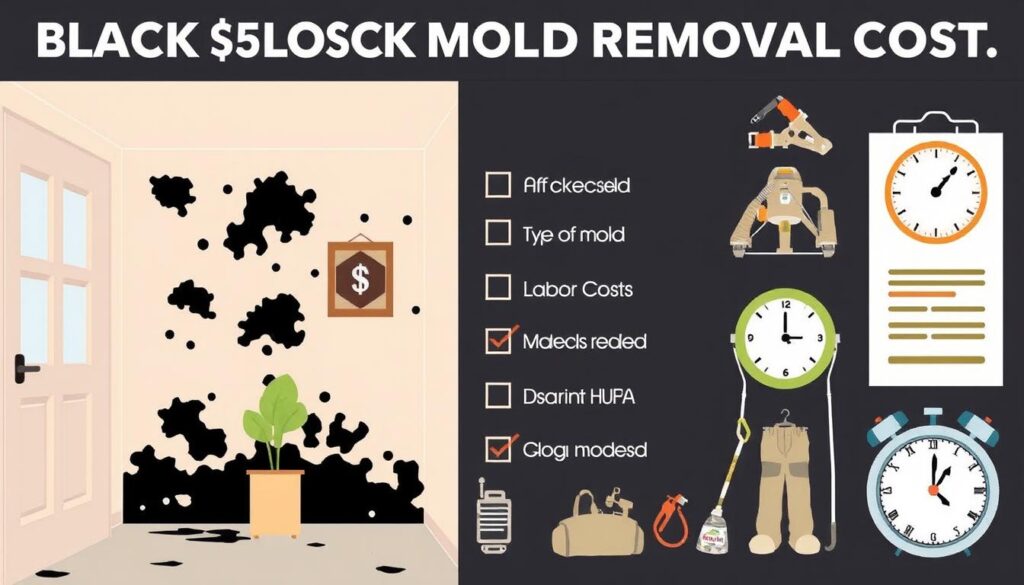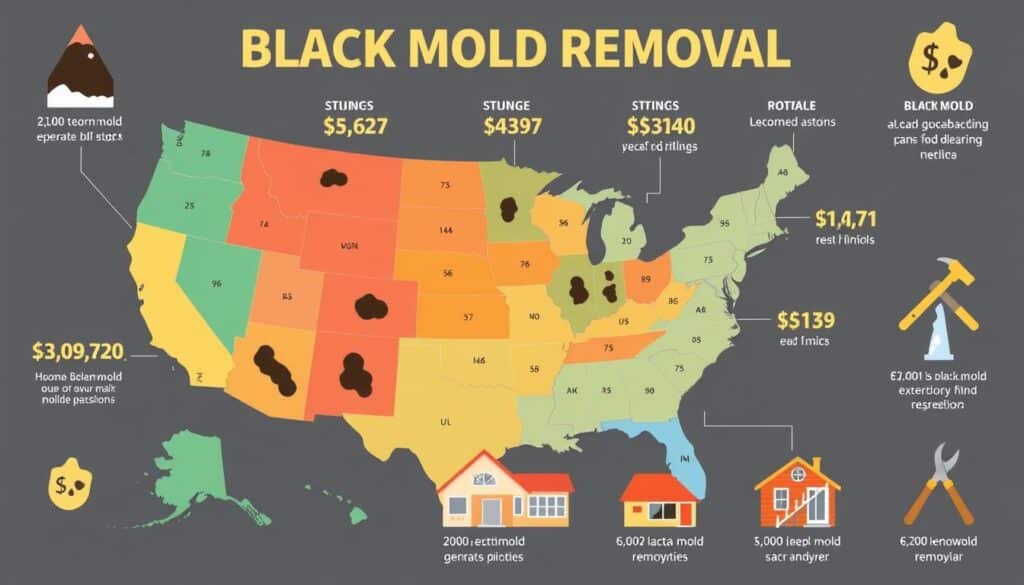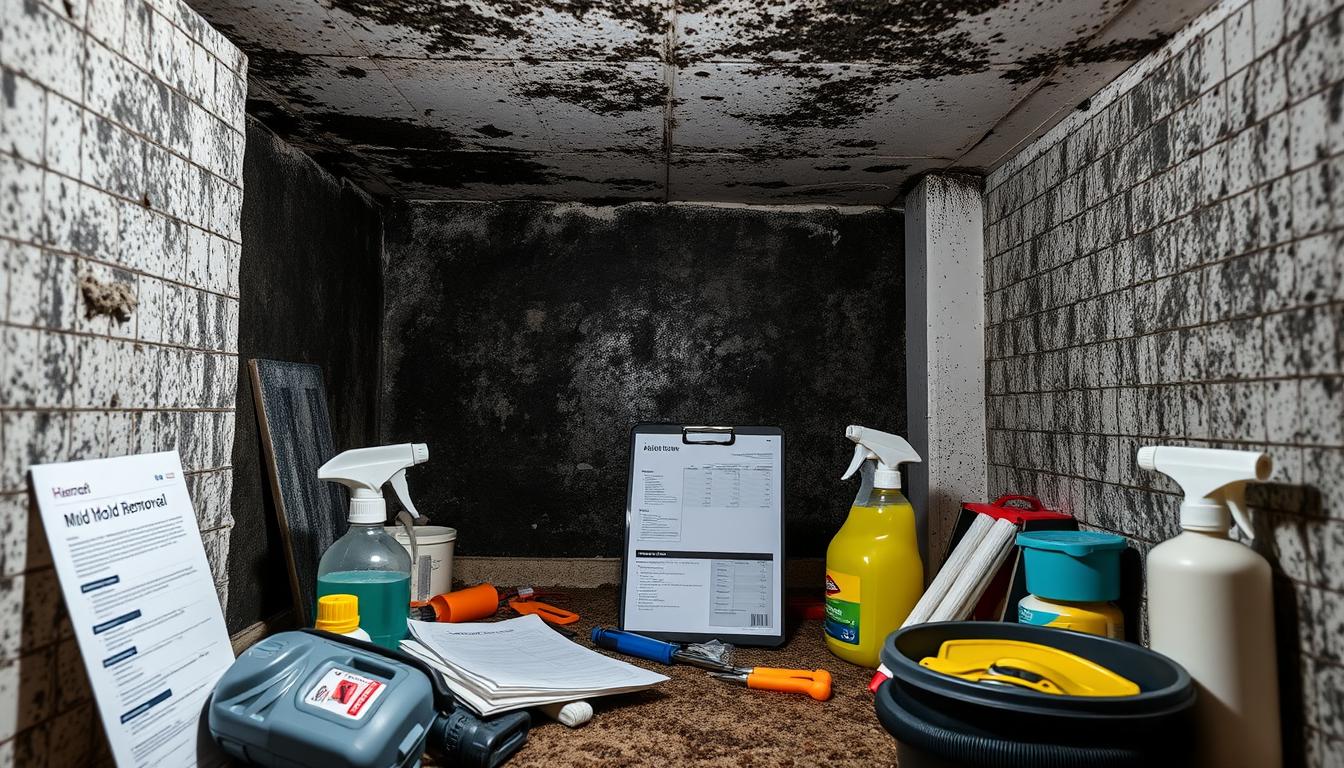Did you know mold removal can cost up to $30,000 for a whole house? I was surprised to find this out while researching. As a homeowner, I’ve always wondered about the cost of dealing with mold. Let’s explore the prices and what affects them.
The cost for toxic mold cleanup varies a lot. On average, it’s about $2,230. But, the price changes based on how bad the mold is and your home’s size. For example, a 1,000-square-foot home might cost $2,500, while a 2,000-square-foot home could be $5,000.
I found that the cost per square foot is between $10 and $25. So, a small 25-square-foot area might cost $250 to $625. But, a bigger 300-square-foot area could cost $3,000 to $7,500.
Key Takeaways
- Mold removal costs range from $125 to $30,000
- Average cost for homeowners is $2,230
- Price per square foot varies from $10 to $25
- Whole-house remediation can cost $10,000 to $30,000
- DIY mold remediation costs between $50 and $300
Understanding Black Mold and Its Dangers
Black mold is a serious issue that can harm your home and health. I’ve seen how it can lead to high black mold abatement expenses if not treated. Let’s explore what black mold is and why it’s important to tackle it fast.
What is black mold?
Black mold, also known as Stachybotrys chartarum, is a fungus that grows in damp, dark places. It became well-known in the 1990s for health concerns. While not all black mold is harmful, it’s wise to be cautious.
Health risks associated with black mold exposure
Being exposed to black mold can cause health problems. Some common symptoms include:
- Respiratory problems
- Allergic reactions
- Headaches
- Skin irritation
In severe cases, long-term exposure can lead to serious health issues. It’s crucial to deal with mold quickly to avoid mold mitigation costs and protect your health.
Common areas where black mold grows
Black mold often grows in humid, organic-rich areas. Some common places include:
| Location | Risk Factors |
|---|---|
| Basements | Poor ventilation, water leaks |
| Bathrooms | High humidity, inadequate ventilation |
| Attics | Roof leaks, poor insulation |
| Crawl spaces | Moisture, lack of sunlight |
Finding these problem areas early can help lower black mold abatement costs. Regular checks and quick action are essential to keep your home mold-free and healthy.
Factors Affecting Black Mold Removal Cost
Several factors can change the cost of removing black mold. Knowing these can help you get ready for the expenses you might face.
Size of the Affected Area
The size of the mold area is key in setting prices. Costs usually range from $10 to $25 per square foot. Small areas under 10 square feet might be doable on your own. But bigger infestations need pros and can raise costs a lot.

Location of the Mold Infestation
The location of the mold also affects the cost. Here’s a look at average costs by location:
- Attic: $1,000 – $4,000
- Basement: $500 – $3,000
- Bathroom: $500 – $1,000
- Crawl space: $500 – $2,000
- HVAC system: $3,000 – $10,000
Extent of Damage to Structural Elements
The damage level also plays a big role in costs. Surface mold on drywall might cost around $1,000 to fix. But if mold goes deep into structures, costs can jump to $20,000 or more. In the worst cases, fixing the whole house could cost between $10,000 and $30,000.
Acting fast can help keep costs down. It’s smart to tackle mold problems early to avoid higher costs and health risks.
Average Black Mold Removal Cost
The cost of removing black mold can vary a lot. It usually ranges from $500 to $30,000+. The price depends on how bad the mold is and how big the area affected is.
Let’s look at the costs by location:
- Unfinished basement: $500 – $4,000
- Attic and ducts: $2,000 – $6,000
- Widespread mold due to flooding: $10,000 – $30,000+
HomeAdvisor says the average cost is $2,241. Most people pay between $1,000 and $3,500. For bigger areas, costs can go up to $6,000.
| Factor | Impact on Cost |
|---|---|
| Size of affected area | Larger areas = Higher cost |
| Duration of mold growth | Longer growth = More extensive damage = Higher cost |
| Type of mold | Some species are more difficult to remove = Higher cost |
| Building materials affected | Porous materials (like drywall) are costlier to treat |
Mold remediation is more than just cleaning. Experts use special tools and wear protective gear, especially for big jobs. This detailed work is why the costs can be higher.
Cost Breakdown by Location
Black mold removal costs change based on where the mold is in your home. I’ll explain the costs for different spots to help you know what to expect when dealing with mold.
Attic Mold Removal Costs
Removing mold from the attic can be expensive because it’s hard to get to. You might spend $1,550 to $3,550 for most cases. For really bad cases, it could cost $5,500 to $7,500. The tough job makes these prices higher.
Basement Mold Remediation Expenses
Basements often get mold because they’re damp. You’ll likely pay $400 to $2,900 for basic cleaning. If you need to fix the structure, it could cost $2,500 to $7,000. Keeping the air moving is important to stop mold from coming back.
Bathroom Mold Elimination Fees
Bathrooms are also common places for mold. You’ll usually spend $450 to $1,100 to get rid of it. For really bad cases, it might cost up to $7,000, especially if you need to fix the plumbing. Keeping the bathroom clean and dry helps prevent mold.
Crawl Space Mold Treatment Costs
Crawl spaces are hard to reach, making mold removal expensive. It can cost $550 to $1,900. If you need to seal the area to stop mold, it will cost more. It’s a good investment to protect your home’s base.
| Location | Minimum Cost | Maximum Cost |
|---|---|---|
| Attic | $1,550 | $7,500 |
| Basement | $400 | $7,000 |
| Bathroom | $450 | $7,000 |
| Crawl Space | $550 | $1,900+ |
Keep in mind, these are just estimates. Your actual cost will depend on how bad the mold is and any repairs needed. It’s important to deal with mold quickly to avoid more damage and health problems.

Professional vs. DIY Mold Removal
When I face a mold problem, I think about whether to go pro or DIY. For small mold spots under 10 square feet, DIY might save money. But for bigger problems, getting a pro is key.
Professional mold removal costs between $1,223 and $3,749, averaging $2,363. This price includes special tools, expert knowledge, and detailed removal. DIY, on the other hand, can cost $50 to $300 for basic stuff.
Experts use high-tech methods like air scrubbers and dry foggers to get rid of mold smells. They also seal off areas to stop mold from spreading. DIY methods can’t match this level of detail, especially for toxic mold cleanup.
Let’s compare professional vs. DIY mold removal:
| Aspect | Professional | DIY |
|---|---|---|
| Cost Range | $1,223 – $3,749 | $50 – $300 |
| Equipment | Specialized (HEPA filters, dry foggers) | Basic (cleaning solutions, masks) |
| Effectiveness | High (complete removal) | Varies (depends on skills) |
| Safety | Ensured (proper containment) | Risk of exposure |
| Time | Quick (1-5 days) | Varies (can take weeks) |
While DIY might seem cheaper, going pro ensures mold is fully removed and won’t come back. For big mold problems or health concerns, it’s best to spend on professional services. This is the smart choice for your toxic mold cleanup budget.
The Mold Remediation Process
Understanding the mold remediation process is key when thinking about mold mitigation costs. I’ll explain the steps in professional black mold abatement. This will help you know what to expect.
Initial Inspection and Assessment
The first step is a detailed inspection. A professional checks how much mold there is and why it’s there. This first look helps figure out how much work is needed and what it will cost.
Containment and Air Filtration
To stop mold spores from spreading, the area is sealed off. Negative air pressure and HEPA air scrubbers clean the air. This step is key for removing mold and affects the cost of black mold abatement.
Mold Removal and Cleaning
The mold removal process uses antifungal solutions on surfaces. Materials that can’t be cleaned are often thrown away. The cost depends on the size of the area and the materials used.
Restoration and Prevention
After removing mold, the area is fixed to its original state. This might include painting, replacing drywall, or new carpeting. Steps are also taken to prevent future mold, which can impact long-term costs.
Professional mold remediation usually takes 1 to 3 days for small to medium projects. Costs range from $1,500 to $6,000 on average. Larger infestations might take up to a week and cost more.
Additional Costs to Consider
When dealing with black mold, it’s crucial to factor in extra expenses beyond the initial mold elimination fees. I’ll break down these costs to give you a clearer picture of what to expect during the remediation process.
Mold Testing and Inspection Fees
Professional mold removal rates often don’t include testing and inspection. These services are essential for identifying the type and extent of mold growth. Mold inspections typically cost between $450 and $800, depending on the size of your home. For smaller houses, you might pay $300 to $400, while larger homes can run up to $1,000.
Repairs and Restoration Expenses
After mold removal, you’ll likely face repair costs. These can vary widely based on the affected areas and materials. Here’s a breakdown of potential expenses:
| Item | Cost Range |
|---|---|
| Drywall Replacement | $50 – $80 per square foot |
| Carpet Replacement | $3.25 – $10.25 per square foot |
| Cabinet Replacement | $120 – $1,425 per linear foot |
| Hardwood Flooring Replacement | $6 – $18 per square foot |
Preventive Measures and Future-Proofing Costs
Investing in prevention can save you money in the long run. Consider these steps to avoid future mold issues:
- Install dehumidifiers in damp areas
- Improve ventilation systems
- Apply mold-resistant paint
- Seal leaks and fix water damage promptly
These preventive measures can add to your initial costs but are essential for maintaining a mold-free home. Remember, professional mold removal rates may not cover these additional expenses, so it’s wise to budget accordingly.
Insurance Coverage for Mold Removal
Insurance for mold removal can be confusing. Many homeowners find out their policies don’t fully cover mold eradication costs. In California, water damage is a common issue, with burst pipes being the top cause. But, mold can grow in just 48 hours after water damage.
Insurance companies often have limits on mold removal coverage. Some policies only cover up to $10,000. To get more protection, you might need to pay extra. It’s important to act quickly if you see water damage. Reporting it fast can help you get coverage for mold-related issues Keep in mind, insurers usually don’t cover mold from long-term leaks or neglect.
Here’s a breakdown of what’s usually covered and what’s not:
| Covered | Not Covered |
|---|---|
| Sudden pipe bursts | Long-term leaks |
| Accidental appliance overflows | Storm flooding |
| Water damage from firefighting | Neglected maintenance issues |
To keep your home safe, control moisture. Check for leaks often, use dehumidifiers in damp spots, and clean gutters. If you see mold, take photos for your claim. Quick action helps prevent damage and health risks.
Conclusion
I’ve looked into the costs of black mold removal, and prices really vary. You might pay as little as $125 for small jobs or up to $30,000 for a whole house. On average, expect to spend about $2.50 per square foot for professional services.
Several things affect mold removal costs. The size of the area, where you live, and the type of mold matter a lot. For example, a 1,000-square-foot home might cost $2,500, while a 5,000-square-foot home could be up to $12,500. Labor, which averages $99 an hour, also adds to the total cost.
Preventing mold is the best way to avoid high removal costs. By controlling moisture and checking for mold regularly, you can save a lot of money. If you think you have mold, call a professional right away. They can remove it completely and stop it from coming back, keeping your home and health safe.
FAQ
What is black mold, and why is it dangerous?
Black mold, or Stachybotrys chartarum, is a toxic mold that can harm your health. It can cause lung damage and, in severe cases, death. It thrives in humid areas with organic materials.
What factors affect the cost of black mold removal?
The cost of removing black mold depends on several factors. These include the area’s size, the mold’s location, and the damage to structures. The complexity of the removal also plays a role.
What is the average cost of black mold removal?
The average cost for removing black mold is between $1,500 and $9,000. Small cases might cost $500 to $1,000. Larger, more complex cases can reach up to $30,000.
How much does it cost to remove mold from specific areas?
Removing mold from attics can cost $1,000 to $9,000. Basements might cost $500 to $4,000. Bathrooms, crawl spaces, and HVAC systems have different price ranges.
Should I consider professional mold removal or DIY?
For large or complex mold infestations, professional removal is best. It ensures safe and thorough removal. DIY is okay for small areas (less than 10 square feet) if you’re not sensitive to mold.
What does the mold remediation process involve?
The process starts with an inspection and assessment. Then, it involves containment, air filtration, and mold removal. Finally, restoration and prevention steps are taken to fix moisture issues and prevent future growth.
What additional costs should I consider for mold removal?
You might need to pay for mold testing and inspection, which can cost $50 to $800. Repairs and restoration, like replacing drywall or flooring, are also expenses. Preventive measures, like fixing leaks, add to the cost.
Is mold removal covered by homeowner’s insurance?
Insurance coverage for mold removal varies. It depends on the mold’s cause, any pre-existing conditions, and your policy. Always check your policy and talk to your insurance provider about coverage.
,000 to ,000. Basements might cost 0 to ,000. Bathrooms, crawl spaces, and HVAC systems have different price ranges.
Should I consider professional mold removal or DIY?
For large or complex mold infestations, professional removal is best. It ensures safe and thorough removal. DIY is okay for small areas (less than 10 square feet) if you’re not sensitive to mold.
What does the mold remediation process involve?
The process starts with an inspection and assessment. Then, it involves containment, air filtration, and mold removal. Finally, restoration and prevention steps are taken to fix moisture issues and prevent future growth.
What additional costs should I consider for mold removal?
You might need to pay for mold testing and inspection, which can cost to 0. Repairs and restoration, like replacing drywall or flooring, are also expenses. Preventive measures, like fixing leaks, add to the cost.
Is mold removal covered by homeowner’s insurance?
Insurance coverage for mold removal varies. It depends on the mold’s cause, any pre-existing conditions, and your policy. Always check your policy and talk to your insurance provider about coverage.




